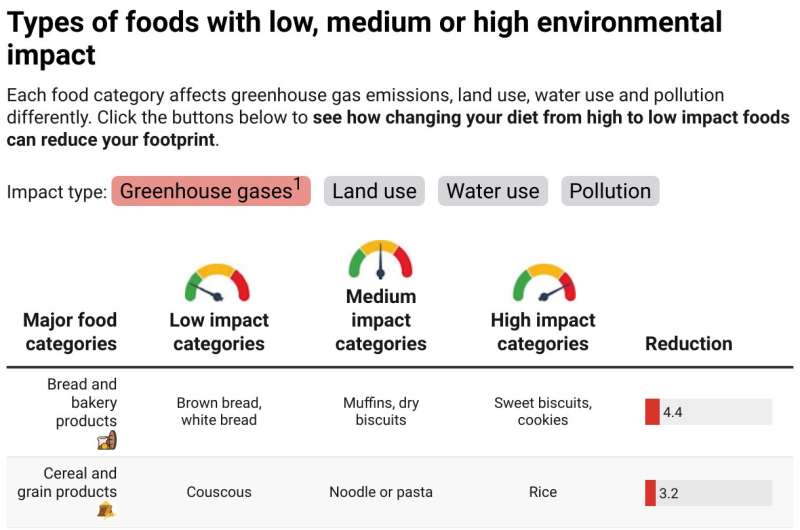This article has been reviewed according to Science X's editorial process and policies. Editors have highlighted the following attributes while ensuring the content's credibility:
fact-checked
trusted source
written by researcher(s)
proofread
How sustainable is your weekly grocery shop? These small changes can have big benefits

You might think eating more sustainably requires drastic changes, such as shifting to a vegan diet. While a plant-based diet is undeniably good for the Earth, our new research shows modest changes to your eating habits can also have significant environmental benefits.
We assessed how food products on Australian supermarket shelves stack up against key environmental indicators, such as carbon emissions and water use.
We found swapping the most environmentally harmful foods for more sustainable options within the same food group, such as switching from beef burgers to chicken burgers, can significantly reduce carbon emissions—by up to 96% in some instances.
The last thing we want to do is take the pleasure away from eating. Instead, we want to help consumers make realistic dietary changes that also help ensure a sustainable future. So read on to find out which simple food swaps can best achieve this.
Informing sustainable diets
The environmental impact of foods can be estimated using an approach known as a life-cycle assessment.
This involves identifying the "inputs" required along the food supply chain, such as fertilizer, energy, water and land, and tracking them from farm to fork. From this we can calculate a product's "footprint"—or environmental impact per kilogram of product—and compare it to other foods.
Most studies of environmental footprints focus on the raw ingredients that make up food products (such as beef, wheat or rice) rather than the packaged products people see on shelves (such as beef sausages, pasta or rice crackers). Of the studies that do focus on packaged foods, most only consider a fraction of the products available to consumers.
What's more, a lot of research considers only the carbon emissions of food products, excluding other important measures such as water use. And some studies use global average environmental footprints, which vary significantly between countries.
Our research set out to overcome these limitations. We aligned environmental footprints with the products people find on supermarket shelves, and covered a huge range of food and beverage products available in Australia. We also included many environmental indicators, to allow a more complete picture of the sustainability of different foods.
What we did
Key to our research was the FoodSwitch database, which compiles food labeling and ingredient data from images of packaged food and beverages. It covers more than 90% of the Australian packaged food market.
We combined the database with a mathematical method that sums the environmental impact of ingredients, to quantify the footprint of the product as a whole.
From this, we estimated the environmental footprint of 63,926 food products available in Australian supermarkets. We then simulated the potential benefits of making "realistic" switches between products—that is, switches within the same food category.
Our findings
The results show how making a small dietary change can have big environmental consequences.
For a shopping basket composed of items from eight food groups, we simulate the benefits of swapping from high-impact towards medium- or low-impact food products.
Our analysis assumes a starting point from the most environmentally harmful products in each food group—for example, sweet biscuits, cheese and beef burger patties.
A shift to the medium-impact foods for all eight items—such as a muffin, yogurt and sliced meat—can lead to at least a 62% reduction in environmental impact. Shifts towards the most sustainable choice for all items—bread, soy milk or raw poultry—can achieve a minimum 77% reduction.
This analysis ends at the supermarket shelves and does not include additional food processing by the consumer. For example, raw meat will usually be cooked before human consumption, which will expand its environmental footprint to varying degrees, depending on the method used.
See the above info-graphic for more detail. The full results are available in our study.
What next?
Many people are looking for ways to live more sustainably. Insufficient or complex information can fuel confusion and anxiety in consumers, leading to inaction or paralysis. Consumers need more information and support to choose more sustainable foods.
Supermarkets and retailers also have an important role to play—for example, by giving sustainable products prominent shelf placement. Attractive pricing is also crucial—particularly in the midst of a cost-of-living crisis when it can be difficult to prioritize sustainability over cost.
Government interventions, such as information campaigns and taxing high-impact products, can also help.
Food labeling is also important. The European Union is leading the way with measures such as the eco-score, which integrates 14 environmental indicators into a single score from A to E.
Apps such as ecoSwitch can also empower consumers.
The diets of people in developed nations such as Australia exert a high toll on our planet. More sustainable food choices are vital to achieving a sustainable future for humanity. We hope our research helps kick-start positive change.
Provided by The Conversation
This article is republished from The Conversation under a Creative Commons license. Read the original article.![]()


















